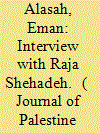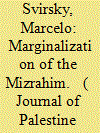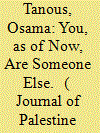|
|
|
Sort Order |
|
|
|
Items / Page
|
|
|
|
|
|
|
| Srl | Item |
| 1 |
ID:
190010


|
|
|
|
|
| Summary/Abstract |
Although Lord Plumer’s tenure as high commissioner for Palestine (1925–28) is sometimes characterized by mainstream Euro-American histories as a period of comparative peace, the year 1927 saw two major disruptions: the Jericho earthquake in July, which caused serious damage to towns and cities including Jerusalem, Nablus, and Lydda; and unrest among Jewish immigrants who found that the local economy had no jobs to offer them—or at least not ones at the European rates of pay to which they were accustomed. This article explores the ways in which each of these crises intersected with Palestine’s infrastructure—in particular its railways, roads, and housing stock. I argue that the disparate ways in which the British administration approached earthquake victims versus the unemployed, the help it offered (or failed to offer), and the policies it implemented are telling about the nature of British governance in Palestine in the mid-1920s and British administrative priorities and concerns. The Mandate authorities’ responses to the quake—characterized by selective negligence—reveal the colonial administration’s weakness, the contested ways in which colonial structures were shaped and operated in the early Mandate period, and the extent to which maintaining a facade before other colonial powers and the League of Nations outweighed substantive action.
|
|
|
|
|
|
|
|
|
|
|
|
|
|
|
|
| 2 |
ID:
190011


|
|
|
|
|
| Summary/Abstract |
This article compares the flag colors device in three films: Paradise Now, When I Saw You, and 3000 Nights. The central question is how Hany Abu-Assad, Annemarie Jacir, and Mai Masri embed the colors red, green, white, and black in their movies, the colors of the Palestinian flag. Three major motivations for the flag device are compared: symbolic rhetoric, artistic play, and narrative composition by examining flag motifs from global cinema (Godard, Kieślowski, and Mehta) and other Palestinian films and paintings. This article argues that Abu-Assad, Jacir, and Masri have used flag colors to structure their films’ form and to cue their narratives.
|
|
|
|
|
|
|
|
|
|
|
|
|
|
|
|
| 3 |
ID:
190015


|
|
|
|
|
| Summary/Abstract |
This interview is part of an ongoing PhD research project on contemporary Anglophone Palestinian memoirs, autobiographies, and life narratives. The project examines the linguistic, aesthetic, and thematic elements of a number of texts that document daily life under occupation in Palestine within a settler-colonial theoretical framework. Interviews with authors have been conducted to foreground the textual analysis of the texts. Due to COVID-19 restrictions, this interview was conducted online via Zoom in February 2022, and was later edited by the interviewer and the interviewee.
|
|
|
|
|
|
|
|
|
|
|
|
|
|
|
|
| 4 |
ID:
190012


|
|
|
|
|
| Summary/Abstract |
This article investigates the institutional attitudes of the Histadrut (the General Organization of Workers in the Land of Israel) toward Palestine’s Middle Eastern Jews (Mizrahim) between 1920 and the late 1940s. Based on archival evidence and secondary sources, it argues that what Mizrahi workers experienced in their dealings with the Histadrut was not the result of random or unintended abuse but of a political culture that promoted social fragmentation and inequality. The corollary of this argument is that the Mizrahim who arrived immediately after 1948 found themselves thrown into a racial binary mold that had been in the making for about fifty years, beginning with the first waves of Zionist immigration to Palestine.
|
|
|
|
|
|
|
|
|
|
|
|
|
|
|
|
| 5 |
ID:
190014


|
|
|
|
|
| Summary/Abstract |
This essay addresses the Israeli designation of “permanent residency,” more commonly known as Jerusalem residency to which Palestinians in occupied East Jerusalem are confined. Since 1967, the Israeli Ministry of Interior has revoked or refused to renew the residencies of nearly 15,000 Palestinians. Masquerading as a democracy, Israel hides behind the center of life doctrine—a set of policies and laws that require people to prove their lives center around Jerusalem, or areas occupied in 1948. Property deeds, rental contracts, employment papers, and utility bills are the documents Palestinians must produce to show evidence of belonging to Jerusalem. This bureaucratic wall of Israeli settler colonialism dispossesses Palestinians and employs fear to ethnically cleanse people who trace generations of ancestry to the city. The author shares her struggles in affirming her claims to Jerusalem and practicing sumud.
|
|
|
|
|
|
|
|
|
|
|
|
|
|
|
|
| 6 |
ID:
190013


|
|
|
|
|
| Summary/Abstract |
This article challenges the dominant notion that the health of Palestinians inside the Green Line can be framed or understood as an issue of “minority health” characterized by a “gap” that needs bridging in order for health equity to be attained. It situates the health of Palestinians in Israel within the realm of Indigenous health and claims that the settler-colonial nature of the state of Israel, the minoritization of Palestinians, and their depeasantization through land policies and water infrastructures have produced an Indigenous community alienated from its lands and from nature. These processes, I argue, contribute to adverse health outcomes that are then reported simply as “minority health” phenomena, chalked up to behavioral patterns or biology. The article seeks to challenge the entire notion of “minority health” as a purportedly neutral statistical unit and to launch a conversation on the health effects of minoritization in settler-colonial contexts.
|
|
|
|
|
|
|
|
|
|
|
|
|
|
|
|
|
|
|
|
|